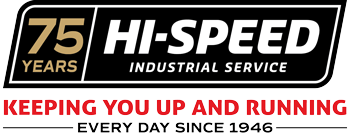Many different businesses utilize overhead cranes to safely and efficiently move parts and assemblies from one work area to next. While understanding their use and purpose is straightforward, comprehending all the guidelines, rules, and regulations governing their use can be quite a challenge.
As part of our commitment to keep you up and running, today we’ll discuss the following overhead crane topics.
- Industry Standards
- OSHA Overhead Crane Requirements
- ANSI/ASME Overhead Crane Requirements
- Safe Crane Practices
After reading this article, please email the Hi-Speed Crane Experts or call us at 800-713-0103 with any questions you may have.
What Are Overhead Crane Industry Standards?
Industry standards are the generally accepted requirements, best practices, or criteria that establish a consistent way for products, services, or operations to be created and performed within a particular industry. They are typically created through voluntary agreements between stakeholders and industry experts to ensure a quantifiable level of quality, compatibility, and safety, benefiting everyone.
All overhead and gantry cranes are subject to a combination of regulations, requirements, or recommendations as outlined by OSHA, ANSI/ASME, and the CMAA.
OSHA Requirements for Overhead Cranes
OSHA 29 CFR 1910.179 is a federal law that applies to the classification, definitions, use, and operation of gantry and overhead cranes. In addition to OSHA, other applicable state or local laws may also need to be considered before operation, such as Cal/OSHA, which requires a load test to be performed every four years.
ASME Standards and ANSI Certifications
It’s essential to recognize that we’re discussing two distinct and independent organizations, although they are typically referenced together.
ASME is the American Society of Mechanical Engineers, which develops mechanical engineering standards related to nuclear plants and pressure technologies.
ANSI is the American National Standards Institute, which accredits the procedures of Standards Developing Organizations (SDOs) like ANSI, and approves their documents as American National Standards.
In short, ASME is a standards developer, while ANSI acts as a facilitator and accrediting body for standards. Here are the most common standards for overhead and gantry cranes.
ANSI/ASME B30.2 covers the construction, installation, operation, inspection, and maintenance of hand-operated and power-driven overhead and gantry cranes.
ANSI/ASME B30.17 provides guidelines for hand-operated and power-operated overhead cranes and monorail systems, including those with either an underhung trolley or bridge, or both.
ASME HST-1 establishes the performance requirements for electric chain hoists that use a welded or roller link chain to vertically lift materials, using a trolley and a lug, hook, or clevis.
ASME HST-2 outlines the performance standards for manually operated chain hoists that use a welded link chain with hoists suspended by a hook, clevis, or trolley.
ASME-3 covers the performance requirements for manually operated lever hoists used for lifting, pulling, and tensioning. These systems utilize either a ratchet-and-pawl or friction-braking mechanism when paired with a welded or roller chain, web strap, or wire rope.
ASME-4 details the performance standards for electric wire rope hoists used for vertical load lists. Suspension options include lug, hook, trolley, and various installations, such as base- or deck-mounted, and wall- or ceiling-mounted cranes.
Industry Standards for Overhead and Gantry Cranes
In addition to the requirements discussed so far, the CMAA (Crane Manufacturers Association of America) is an independent trade organization that establishes the crane duty classifications and training requirements for crane operators.
Here are the five most referenced standards for overhead cranes.
- CMAA-70: Specifications for Top Running Bridge and Gantry Type Multiple Girder Electric Overhead Cranes
- CMAA-74: Specifications for Top Running and Under Running Single Girder Electric Traveling Cranes Utilizing Under Running Trolley Hoist
- CMAA-78: Standards and Guidelines for Professional Services Performed on Overhead and Traveling Cranes and Associated Hoisting Equipment
- CMAA-79: Crane Operator’s Manual
- CMAA-80: Below-the-Hook Lifting Device Operator’s Manual
The CMAA also maintains an extensive library of technical publications, which includes safety checklists, proper use and operation guidelines, as well as maintenance and inspection schedules.
Safe Crane Practices
Planning, communication, and visibility are key across every step of the loading and lift processes to ensure speed, accuracy, and safety. Before moving a load, it is essential to ensure the operators are adequately trained and the workspace is clear of potential hazards.
It is important to incorporate daily pre-use inspections, proper rigging techniques, and review safety features and how they work to provide maximum protection for workers and materials.
We’ve covered a lot of crane topics today. If you have any questions about crane classifications, or proper use and inspections, please call the team at 800-713-0103 or email the Hi-Speed Material Handling Experts today.
Related Topics and Information
Due to your interest in overhead crane regulations and standards, here are some additional articles that might interest you.
Overhead Crane Options for Tight Spaces

